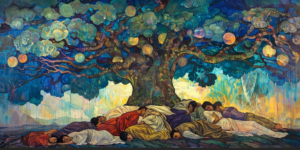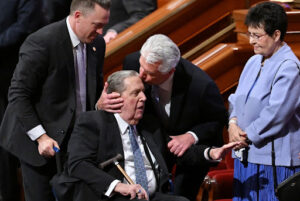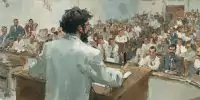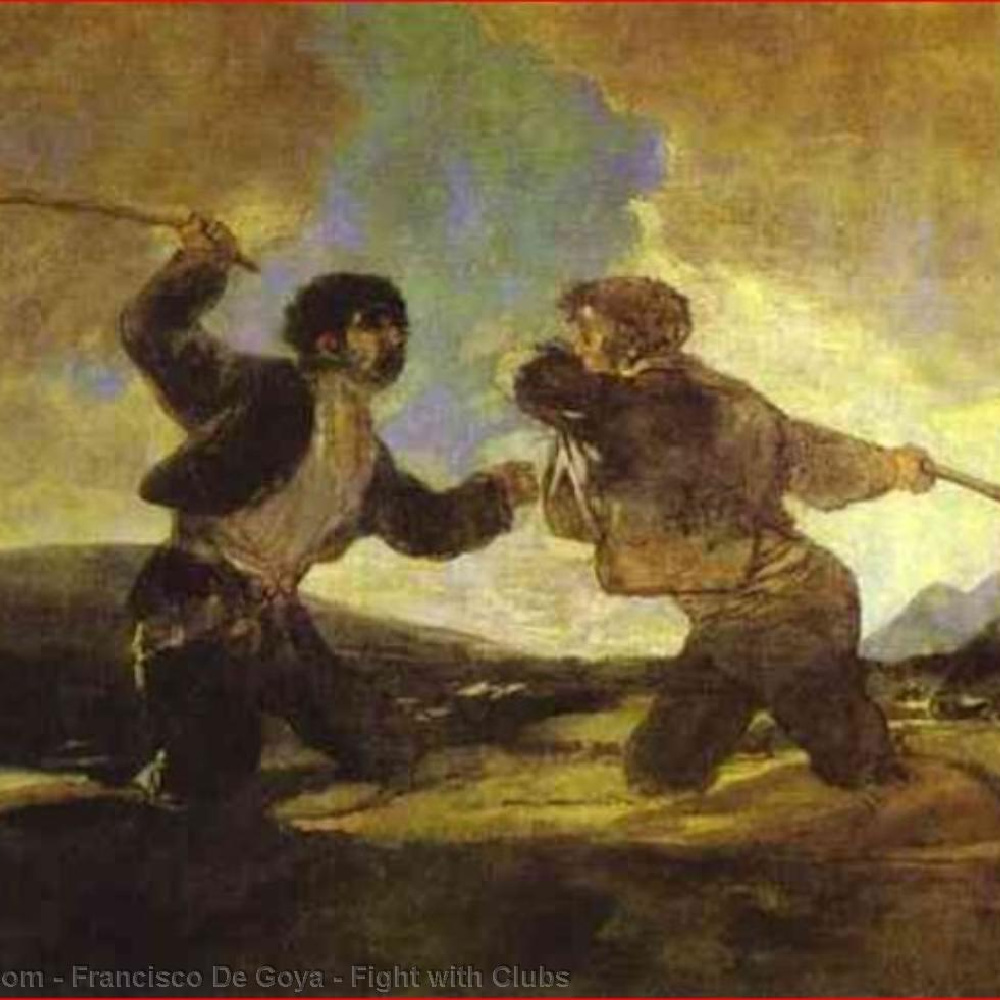In the shocking criminal trial of Chad Daybell, Latter-day Saints were left asking what happened here. How did a church member go so far off the rails? What are the things that lead people out of the mainstream of the Church and into apostate ideologies and horrifying criminal behavior?
To answer these questions in the story of Chad Daybell, we first need to understand that Chad Daybell was not alone in his journey into madness. By now, many church members are familiar with the picture of law enforcement encountering Chad Daybell and his then-new wife Lori Vallow by the side of a pool in Hawaii, where Daybell and Vallow had been reading from the book Visions of Glory, a book created by the late John Pontius in conversations with Thom Harrison.
The genre of Visions of Glory is apocalyptic, similar to the biblical Book of Revelation and other similar passages in scripture. Visions of Glory purports to be an account of a series of Thom Harrison’s near-death experiences, with elaborate apocalyptic visions of the future of the world and the Church. In a letter to his priesthood leaders following the book’s publication, Thom Harrison walked back much of the contents of the book and expressed regret for its publication, though his statements in other settings seem to convey none of that regret. Could a downward spiral like this happen to anyone?
When Daybell met Lori Vallow in October 2018, it was a meeting of two delusion-prone individuals with deep emotional and psychological cravings, surrounded by enabling friends whose apostate ideas helped accelerate the couple’s downward spiral into evil. And observing this, believing and sustaining mainstream Latter-day Saints are once again left with questions that are ominous, unsettling, and personal in nature: could a downward spiral like this happen to anyone? Could it happen to the people around me in church? Could it possibly even happen to me?
A large part of the challenge in thinking through the Daybell and Vallow cases has to do with the fact that they claimed as a basis for their apostasies and criminality some phenomena that are real elements of our faith. We do believe in prophecy, including apocalyptic prophecy about the future. We do believe in spiritual discernment, and as I wrote recently, we certainly do believe in the demonic. We also believe in revelation that sometimes comes in out-of-body experiences while near death, among other situations.
How, then, are all of these realities hijacked and counterfeited by people who are consumed with delusion and evil?
In our cravings for simplistic and trite answers, we might point to mental illness, or to simple character flaws, or to religious indoctrination. But there are many people for whom some or all of those factors apply who never end up embracing the delusional evil that drove Daybell and Vallow.
On the question of mental illness, mainstream psychology might address the behavior of Daybell and Vallow with references to family systems, cognitive behavior, psychosis, and other clinical concepts. All of these are valuable and can shed light on different dimensions of this awful story. But beyond mainstream psychology, Jungian analysis offers an interesting way of thinking that resonates with our restoration doctrines in important ways.
The great psychologist Carl Jung was a close associate of Sigmund Freud for a time, and they shared an understanding that our lives are influenced to a great degree by our subconscious. The subconscious is a dimension of the heart and mind containing our life experiences and observations of the world since birth, along with our responses to those experiences and observations. A great amount of effort in psychotherapy is oriented toward helping clients to identify motives and drives that come from the subconscious and helping them to reprocess in healthier ways the experiences and observations that reside there below our awareness.

Carl Jung and Sigmund Freud underwent a professional split, and a major reason for their split was Jung’s belief in another layer of the psyche deeper than the subconscious, which he called the “collective unconscious.” Jung’s belief in the collective unconscious arose from his study of dreams, visionary stories, and mythologies throughout the world. In these, Jung found distinctive common elements, even in cultures that were isolated from the influence of the world’s great religions and mythological literature. Jung inferred that in the psyche of every human being, there is a vault of “archetypes,” stories and figures, and even archetypal patterns of lived experience that reflect how the world works.
Archetypes are perceived in concepts like hero, mother, warrior, trickster, rebel, magician, lover, wounded healer, and more. They are the basis for humanity’s stories, and we encounter the archetypes in our experiences of life.
The notion of the collective unconscious should resonate with Latter-day Saints, as we read in restoration scripture: “For I, the Lord God, created all things, of which I have spoken, spiritually, before they were naturally upon the face of the earth (Moses 3:5).” Or in Jung’s words, “The form of the world into which [a person] is born is already inborn in him, as a virtual image.” For Latter-day Saints, the restoration allows us to understand the “forms” of our world, what Jung called archetypes in our collective unconscious, as memories from this world’s spiritual creation and our lived experiences of premortality.
Jung viewed apocalyptic experiences as “archetypal,” shared across religions and cultures and continents. In modern psychology, experiences of visions, including apocalyptic visions of the end times, are classified as psychosis, a form of mental breakdown. But Jung held that these experiences are more accurately described as an eruption of archetypal concepts coming up from the collective unconscious. But on its way into our conscious mind, an archetypal concept like apocalyptic vision passes like a game of telephone through our subconscious, where it is shaped by our culture along with our life experience and other reference points. We see this evidenced in the different personal stylistic and other “flavors” that characterize apocalyptic visions from prophetic figures in scripture.
In the Jungian view, an experience of apocalyptic psychosis can serve a positive purpose, creating a process of psychological renewal. He held that view due to the fact that many people throughout the world who have these experiences do return to full mental wellness, often better than they were before the experience. In a Latter-day Saint view, this makes sense: in our engagement with apocalyptic material like the Book of Revelation, we find ourselves situated in the great story of good and evil in the world, the grand contours of humanity’s spiritual history. In the context of this great story, adversity and suffering have meaning. And we know that evil will be overcome in the end, followed by renewal. This is a vastly more healthy psychological perspective compared to nihilism, where people see themselves as soulless, life as meaningless, and world events as a thrashing around of random evolutionary forces.
But there is an element in the development of apocalyptic stories that speaks directly to questions of discernment. As documented in Christopher Blythe’s book Terrible Revolution, apocalypticism tends to both attract and fuel extremism, and we would do well to understand why. One of our greatest frameworks for discernment is the three temptations of Christ, where we see the three root causes of evil in the world: a perception that our physical appetites and cravings need fulfillment; that we need recognition and validation; and that our problems could be solved if we had more power and control. The three temptations are a satanic misinterpretation of real human needs, and their influence extends to life in general, including experiences of religion and revelation. To use an analogy, a drug addict comes to view every human encounter and every life event through the lens of their addiction and tends to think of everything in terms of how it can lead them to their next high. In the same way, a person with unhealed cravings around physical appetites, recognition/validation, or power/control will interpret even their religion in ways that reflect those bottomless pits in the soul. In the Jungian view, an experience of apocalyptic psychosis can serve a positive purpose.
The pathological element only reveals itself in the way the individual reacts to them and how he interprets them. The characteristic feature of a pathological reaction is, above all, identification with the archetype. This produces a sort of inflation and possession by the emergent contents, so that they pour out in a torrent which no therapy can stop. Identification can, in favourable cases, sometimes pass off as a more or less harmless inflation. But in all cases, identification with the unconscious brings a weakening of consciousness, and herein lies the danger. You do not “make” an identification, you do not “identify yourself,” but you experience your identity with the archetype in an unconscious way and so are possessed by it.
This insight provides a tremendously useful way to understand the emergence of false prophets. The way we conceptualize the term “prophet” can be greatly warped by culture and other subconscious factors to a degree that we no longer have a healthy or realistic relationship with that archetype. The Christ spoke of John the Baptist and said, “What went ye out into the wilderness to see? A reed shaken with the wind? But what went ye out for to see? A man clothed in soft raiment? behold, they that wear soft clothing are in kings’ houses.” Joseph Smith is reported to have gone in plain clothes to meet a group of new converts and asked one of them, “I suppose you are looking for an old man with a long, gray beard. What would you think if I told you I was Joseph Smith?”
In both of these instances, the questions being asked are interrogating the hearers’ experience of the archetype of prophet. Do they have an erroneous mental model of the prophet archetype based on their culture or other influences? In the prepper communities where people like Chad Daybell and Lori Vallow met, the archetype of prophet seems to have been greatly warped by Visions of Glory and other similar works that seem to conflate the archetypes of prophet and magician. Several individuals have gone so far as to personally identify with this warped prophet archetype, producing streams of fabulist false prophecy.
Still others have tried to identify with the archetype of Aaron, the prophetic interpreter for Moses. They see passages like Jeremiah 23 and Ezekiel 34 that condemn ancient Israelite religious leaders, and in a perversion of Aaron’s role, they erroneously interpret those passages as applying to the current leadership of The Church of Jesus Christ of Latter-day Saints. They combine those with servant passages in the book of Isaiah to create a narrative that the president of the Church is not a prophet but merely a “key-holder,” waiting for a future “Davidic servant” who will vanquish the Church’s enemies. “Davidic servant” narratives combine the archetypes of prophet, magician, hero, and warrior, and it is not surprising that a number of commentators in the Church have sought self-importance by appropriating that surrealist Frankenstein of an archetype.
We can conclude by asking a difficult question, one with a hopeful and joyful answer.
The question is whether a delusional fabulist false prophet might emerge in the governing councils of The Church of Jesus Christ of Latter-day Saints. This question is easy to answer, and the reality is that this kind of risk in the Church is practically nil. To understand why, we need to go back into church history.
In the kind of honesty that brings a smile to the faces of Jungians everywhere, Brigham Young frankly acknowledged that he saw no need to be like Joseph Smith. And this might sound shocking to believing Latter-day Saints who might wonder if Brigham Young was denying the prophetic mantle in the Church.
The answer? Not at all.
Brigham Young knew he didn’t need to appropriate whatever archetypal vision of prophethood that might have formed around Joseph Smith. Brigham could exercise the prophetic mantle with his personal gifts, which were different from Joseph’s gifts, which were different from the gifts of John the Baptist, whose prophetic gifts differed from those of Isaiah, whose gifts differed from those of Moses, and on and on. The term “prophet” can be greatly warped by culture and other subconscious factors.
The emergence of our current system of prophetic succession has been a godsend. In it, we find a steady and reliable guard against the kinds of perverse incentives that have placed sensationalist false prophets and false teachers at the head of so many Christian communities in the present day. The men in line for prophetic succession in the Church spend many years deliberating in the council system, where President James E. Faust described, “this requirement of unanimity provides a check on bias and personal idiosyncrasies.”
All of our current members of the First Presidency and Quorum of the Twelve are part of a generation of church leadership that either witnessed or directly participated in church governance during the ministry of President Spencer W. Kimball. In his book Charity Never Faileth, Vaughn J. Featherstone recalled an experience with then-Elder Kimball of the Quorum of the Twelve:
Some time ago, I had the privilege of attending a stake conference in the company of President Spencer W. Kimball, before he became president of the church. Elder Kimball worked tirelessly, holding one meeting after another until late Saturday night. On Sunday, we held a meeting with bishoprics and high councilors at eight a.m. This was followed by the general session, a meeting with the seventies quorum, an interview with the patriarch, and the dedication of a chapel, with a talk to seminary students in the evening. We went to the stake president’s home about nine o’clock to wait for our plane, which did not leave until nearly eleven. The stake president’s wife wanted to fix us dinner, but Elder Kimball said,
“Please, all I need is a bowl of milk and some of your homemade bread to break up in it.”
The biography Lengthen Your Stride is full of similar stories of President Kimball, like this one involving Elder Neal A. Maxwell:
As they both sat on the stand in their home ward sacrament meeting, Spencer took Neal Maxwell by the hand and whispered, “Do you know that I love you with all my heart?” The next week, Spencer renewed the sentiment: “Do you remember what I said to you last week?”
Elder Maxwell would later recall of Elder Howard W. Hunter in a talk at BYU,
The Acting President of the Council of the Twelve, President Howard W. Hunter, is a meek man. He once refused a job he needed as a young man because it would have meant another individual would have lost his job. This is the same lowly man, when I awakened after a weary and dusty day together with him on assignment in Egypt, who was quietly shining my shoes, a task he had hoped to complete unseen.
Elder Ezra Taft Benson was notoriously politically active, offering frequent and intense denunciations of communism. When he became president of the Church, many church members dreaded the possibility that the Church would be steered in an overtly political direction. Other members of the Church celebrated this possibility, anticipating that the Church would become the force they envisioned for defeating communism in the world. But in his opening press conference as president of the Church, President Benson offered a statement that shattered any warrior-prophet archetypes that people had fashioned for him:
My heart has been filled with an overwhelming love and compassion for all members of the Church and our Heavenly Father’s children everywhere. I love all our Father’s children of every color, creed, and political persuasion. My only desire is to serve as the Lord would have me do.
In the October 2014 general conference, Elder Jeffrey R. Holland spoke of an instance where he was impacted by Elder Thomas S. Monson:
In that regard, I pay a personal tribute to President Thomas Spencer Monson. I have been blessed by an association with this man for 47 years now, and the image of him I will cherish until I die is of him flying home from then–economically devastated East Germany in his house slippers because he had given away not only his second suit and his extra shirts but the very shoes from off his feet. “How beautiful upon the mountains [and shuffling through an airline terminal] are the feet of him that bringeth good tidings, that publisheth peace.” More than any man I know, President Monson has “done all he could” for the widow and the fatherless, the poor and the oppressed.
Finally, in every general conference, church members are deeply impacted by witnessing the personal affection that the First Presidency and the Quorum of the Twelve have for each other:

This is a culture that has prevailed among the Quorum of the Twelve Apostles for many years. Any church leader who passes through that quorum into the presidency of the Church will have been profoundly shaped by decades of these kinds of daily interactions that short-circuit personal tendencies toward selfishness and egomania. The prophetic mantle in the Church of Jesus Christ cannot be stolen or appropriated by dominant personalities or by leaders of apostate factions. The emergence of our current system of prophetic succession has been a godsend.
In the time of Isaiah, people wanted a spectacular dominant archetypal figure more than they wanted, in Isaiah’s language, “the waters of Shiloah that go softly.” The steady, calm, and reliable influence of God was not answering their cravings for power and for the sensational. So Isaiah informed the people that they would be given what they desired:
…even the king of Assyria, and all his glory: and he shall come up over all his channels, and go over all his banks:
And he shall pass through Judah; he shall overflow and go over, he shall reach even to the neck; and the stretching out of his wings shall fill the breadth of thy land, O Immanuel.
The king of Assyria inflicted horror upon Judah, and the message from Isaiah seems to be that if we are dominated by a desire for archetypal figures instead of real, steady, saving prophetic influence, God will give us the thing that we desire.
By contrast, amid the sadness and horror of the Daybell trial, the good news is that we can have every confidence that the leadership structure of The Church of Jesus Christ of Latter-day Saints will only ever produce authentic prophets and not warped archetypes of the real thing.

















